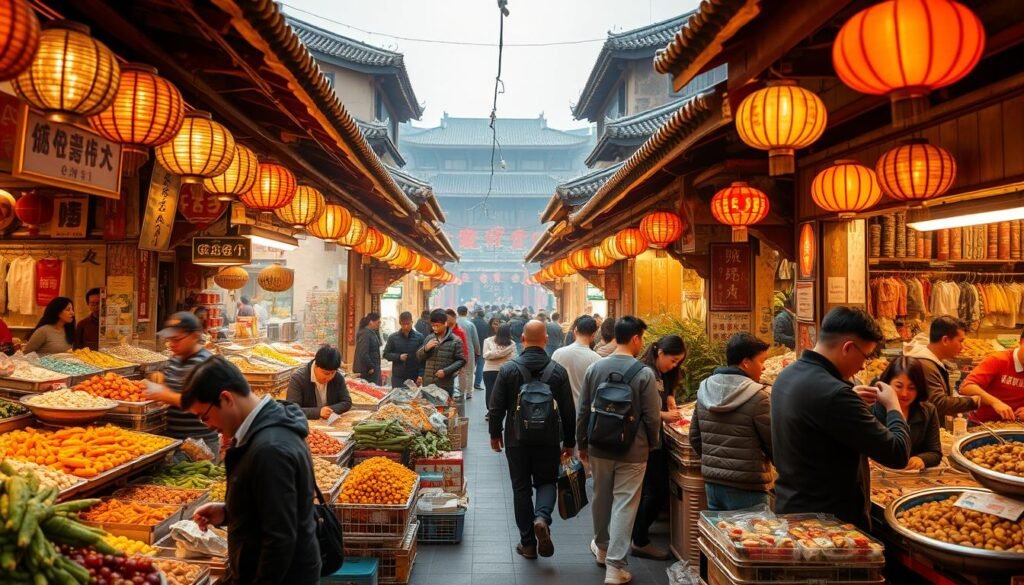In the markets of Hefei, the smell of smoked pork and wild herbs fills the air. This city is a treasure trove of Anhui food, with a history of mountain greens and old stews. Hefei’s food is more than just meals; it’s a journey through landscapes and history.
Every dish here tells you a story. It’s about farmers picking bamboo shoots at dawn or chefs cooking over open flames.
Your journey begins at dawn, where wild mushrooms grow. These ingredients are the heart of Anhui’s kitchens. They show the true spirit of Anhui’s food, often missed in Chinese traditions.
Visiting Hefei is a chance to taste real Chinese food. You can enjoy tea-infused dishes or try Li Hongzhang Hotchpotch. Each bite is like finding a hidden treasure.
Hefei’s chefs are on a mission. They want to keep traditions alive but also innovate. They create dishes that honor their roots and welcome new tastes. If you’re seeking real Chinese food, Hefei is a discovery waiting to happen. Culinary travel to Hefei is more than just eating; it’s a journey between old and new.
Key Takeaways
- Hefei’s cuisine blends wild foraged ingredients with techniques spanning generations.
- Anhui food’s understated elegance challenges perceptions of traditional Chinese dining.
- Authentic Chinese food in Hefei thrives where mountains meet urban life, preserving cultural heritage.
- Exploring Hefei’s markets reveals hidden gems like Bagongshan tofu and rare seasonal vegetables.
- This city redefines culinary travel through its celebration of both simplicity and complexity in cooking.
The Undiscovered Flavors of Anhui’s Capital
When you arrive in Hefei, you can smell the Anhui cuisine characteristics. You’ll notice smoky braises and earthy greens. It’s different from Sichuan’s spicy dishes or Cantonese’s fine details. This city, often missed in food talks, has a rich Hefei food culture.
Why Hefei Cuisine Deserves More International Recognition
Try authentic Anhui dishes like Bagongshan tofu. It’s smooth and pairs well with smoky bamboo shoots. These dishes show Hefei’s patience in cooking. Yet, Hefei is a underrated Chinese food city, hidden by its famous neighbors.
Setting the Stage: Hefei Culinary Identity in Chinese Gastronomy
Hefei’s food scene is often overshadowed by places like Chengdu and Beijing. But its Anhui cuisine characteristics are unique. It uses wild herbs from Huangshan and river fish glazed with vinegar. This shows that simplicity can be just as good as bold flavors.
First Impressions of Hefei’s Food Scene
In the Old Town market, you see a li hongzhang hotchpotch cooking. It is a mix of sweet dried fruit and savory meats. Locals say it tastes like home. Like Tuscany’s secret vineyards, Hefei’s best spots are hidden. Discover them for yourself.
Historical Roots of Hefei Culinary Traditions
Walking through Hefei’s oldest neighborhoods, you discover Anhui food history through dishes like stewed soft-shelled turtle. This recipe dates back to the Ming Dynasty. The region’s tough terrain leads you to creative cooking, like smoking and slow simmering to keep food fresh in harsh winters. These ancient Chinese cooking techniques are key to traditional Hefei recipes today.

“Hefei’s kitchens were once laboratories of survival,” explains Mrs. Chen, a 78-year-old culinary historian. “Every scrap of wild vegetable or river-caught fish became a masterpiece.”
The city’s spot on the Grand Canal brings in spices and new ideas. But Hefei’s chefs keep their own style, blending cultural influences on Anhui food. Take steamed stone frog, a Qing-era dish. Its careful making shows techniques from over 800 years ago.
| Traditional Recipe | Historical Significance |
|---|---|
| Bamboo Shoots in Black Bean Sauce | Originated as a famine-era staple, now a symbol of resilience |
| Mountain Tea-Smoked Duck | Developed during the Song Dynasty for long-distance merchant trade |
In Ming-era Huaiyue Temple kitchens, you see clay pots for braising dishes like Preserved Meat with Wild Mushrooms. These old ways, like steaming fish with bamboo leaves, show Hefei’s cooking spirit lives on. Every bite here is a link between the past and now, where history is savored.
Wild Foraging: The Secret Backbone of Authentic Anhui Dishes
Every morning, you enjoy foragers in misty valleys. There, wild food foraging China traditions come alive. The forest floor reveals secrets of edible wild plants Anhui.
These ingredients are more than just food. They are the heart of Anhui’s culinary soul.
Mountain Herbs That Define Local Flavors
Huixiang leaves add a spicy kick to pork stews. Wild ginger flowers bloom briefly in spring. Elders steep their petals into teas.
These Chinese mountain herbs are gathered with care. Their uses have been passed down for generations.
Seasonal Treasures: Nature’s Clockwork
- Spring: Fiddlehead ferns unfurl, their tender tips prized in stir-fries
- Summer: Wood ear mushrooms cling to tree bark, adding chewy contrast to broths
- Fall: Pine nuts harvested from ancient forests crown savory rice cakes
Chefs use these seasonal wild ingredients to create menus that reflect the land’s rhythms.
Mushroom Hunting as Sacred Ritual
Under 78-year-old Li Wei’s guidance, you learn to spot edible xianggu. The prized zhuling fungus grows on dead chestnut trees. It’s a treasure hidden under moss.
Ethics Etched in Every Harvest
As demand rises, communities balance tradition with sustainable foraging practices. “Take only what the mountain gives freely,” Master Li says. This aligns with Epicurean Escape’s mission to preserve cultural treasures.
Young foragers now use apps to document microclimates. This ensures harvests don’t deplete tomorrow’s bounty.
A Complete Culinary Tour of Hefei (Anhui Province)
Your journey through Hefei’s culinary heart feels like savoring a slow-cooked dish — rich, patient, and deeply rewarding. Each day reveals layers of tradition and sparks of discovery, blending the familiar with the unexpected in every bite.
From dawn’s misty markets to night’s sizzling streets, you explore the essence of cultural tourism Anhui through its flavors.

Day Markets vs. Night Markets: Which Offers the Better Experience
Day markets, like the bustling Hefei food markets at Mingguang, shows vendors arranging herbs with great care. But night markets are where street food comes alive. Hefei street food stalls fry scallion pancakes until they crackled, filling the air with their scent.
“Morning teaches you roots; night reveals its soul,” an elder vendor says. Her hands shapes dough into best restaurantsb secrets in Hefei .
Hidden Gems Off the Tourist Path
A narrow alley leads you to Li’s Family Kitchen, where the matriarch hands you a bowl of bamboo shoot soup. Each sip rich with decades of mastery. Just around the corner, you step into Old Zhang’s Hutong Baozi, where you bite into steamed buns stuffed with wild mushrooms, crafted from a recipe passed down through generations.
These spots embody the cultural tourism Anhui ethos—places over perfection.
The Must-Try Signature Dishes
Each bite of Anhui signature dishes tell you a story. Li Hongzhang Hotchpotch’s harmony of 18 ingredients, Bagongshan tofu’s silken texture, and smoked ham paired with spring bamboo shoots are unforgettable.
These dishes are not just meals—they’re dialogues with history.
The Art of Slow Cooking: Traditional Techniques That Elevate Hefei’s Cuisine

In a dimly lit kitchen, you watch Master Li carefully tend to a clay pot crackling over charcoal. For eight hours, you see bamboo shoots and pork simmer in a slow, patient dance of traditional Anhui stewing methods — transforming tough, humble ingredients into soft, velvety perfection. Clay pot cooking China is more than just a method—it’s magic.
Each time you adjust the flame, it feels like a quiet lesson passed down through centuries of traditional Anhui cooking methods. You realize patience is everything here. It’s what transforms simple ingredients into deep, rich flavors.
“Time is our co-chef,” Master Li says, stirring broth that had reduced to a golden elixir. The slow cooking of Chinese slow cooking methods reflects Taoist balance. It’s a mix of fire and water, speed and calm.
Preservation techniques in Chinese cuisine rely on this balance. They keep food fresh without using modern shortcuts. Even the faintest steam carries stories of Anhui’s mountains.
Modern kitchens now use these old ways in new ways. At innovative Hefei restaurants, chefs mix preservation techniques Chinese cuisine with modern tech. Yet, they always respect the old ways. The crackling of embers under clay pots teaches us: true depth comes from slow, deliberate time.
Sweet Meets Savory: The Unexpected Flavor Combinations That Challenged My Palate

Your journey through Hefei’s kitchens begins with doubt. How could sweet and savory Chinese dishes like Li Hongzhang stew or Bagongshan tofu recipe work together so well? The secret is Anhui’s skill in balance.
Li Hongzhang Hotchpotch: A Symphony of Paradoxes
Imagine trying Li Hongzhang stew. It has sea cucumber’s saltiness, chicken’s creaminess, and bamboo’s earthiness. A sweet honey glaze ties it all together. This culinary paradox seems odd at first but becomes a perfect blend. A chef says, “We mix contrasts to show depth, not conflict.”
- Sea cucumber: Briny ocean essence
- Ham: Salty umami backbone
- Honey: The unifying sweet note
Bagongshan Tofu: Simplicity’s Triumph
An 80-year-old master teaches you about Bagongshan tofu recipe. It’s all about slow savoring. The tofu’s softness, with caramelized ginger and sugar-glazed shiitakes, your understanding of simplicity begins to shift. “Flavor Anhui flavor profiles need patience,” she says, showing how sugar enhances, not overpowers.

Sugar’s Subtle Power
| Ingredient | Traditional Use | Modern Twist |
|---|---|---|
| Lotus root | Sweetness balances gamey meats | Sliced with black vinegar drizzle |
| Preserved plums | Acid-sweet in braised dishes | Included in unusual Chinese flavor combinations like plum-glazed pork |

A chef shared,
“Sweetness here is a brushstroke—not the canvas.”
Their Li Hongzhang stew shows it: a single sugar crystal can make wild boar broth shine.
These lessons change your taste. Hefei’s flavors are not opposites; they’re conversations. Every bite tells you a story of centuries of trying new things, making the unknown unforgettable.
From Home Kitchens to High-End Restaurants: Where Tradition Meets Innovation

Walking through Hefei’s alleyways, you see modern Anhui cuisine come to life. In innovative Hefei restaurants, dishes from family kitchens now impress on fancy tables. This change isn’t a break—it’s a conversation.
Grandmother’s Recipes in Modern Settings
Madame Zhang’s fermented tofu, a family heirloom, now wows as a fancy appetizer at her grandson’s place. The traditional vs modern Chinese cooking debate? Not here. His kitchen keeps her methods but presents them in a new way. “The essence stays,” he says, “but new presentation gives old stories a fresh twist.”
The New Wave of Hefei Chefs Redefining Local Cuisine
Chef Lin, trained in Paris, blends molecular gastronomy with local flavors. His contemporary Chinese chefs style turns an old soup into gelatin spheres, each bursting with modern Anhui cuisine magic. “Technique evolves,” he says, “but respect for ingredients remains constant.”
How Authenticity Varies Across Dining Establishments
Authenticity shows up in many ways, from village stalls to Michelin-starred spots. A simple tofu shop’s authentic Chinese dining experiences differ from fancy versions—but both respect their roots. To explore this range, contact our team for guided tours through Hefei’s kitchens.
“A dish’s soul isn’t in its presentation—it’s in its story,” a forager tells you at a bustling night market, her basket brimming with wild herbs. This truth is at the heart of Hefei’s culinary transformation.
The Global Influence on Hefei’s Evolving Food Scene
In a hidden spot in Hefei, you try a dish that perfectly reflects the city’s blend of flavors — smoked ham from the nearby mountains floating in a rich, savory broth. With every bite, you taste how Hefei’s take on fusion food is reshaping Chinese cuisine, blending international influences into something entirely new.
Chefs like Chef Li, who learned in Tokyo, are making local dishes in new ways. They use global cooking methods to update old favorites.

At the Hefei Culinary Academy, students learn to mix Western impact on Chinese cooking with old traditions. Director Chen says, “We’re not getting rid of tradition. We’re teaching it to grow and change.”
They make dishes like braised river fish with Thai chili glaze. Or sesame-scented rice cakes with Himalayan salt. These new dishes are popular, but some people miss the old ways.
“Gastronomy here is no longer a monologue but a conversation,” Chef Lin looks at you thoughtfully and says, plating a duck confit wrapped in bamboo leaves—a nod to both Périgord and the Anhui hills.
Now, you can find matcha-infused maotai buns and old soy sauces at markets. This shows Hefei’s mix of old and new. The city’s food scene is both a respect for tradition and a step into the future.
Conclusion: Why Hefei Deserves a Place on Every Culinary Adventurer’s Bucket List
Exploring Hefei’s kitchens and markets show you a food culture rich in tradition and simplicity. Wild herbs, foraged mushrooms, and humble tofu dishes reflect Anhui’s natural beauty and changing seasons. This is best scene in a bowl of tofu soup that can move you to tears.
If you are looking beyond Michelin stars, visit Hefei food is a key to China’s hidden culinary gems. It’s a chance to experience the authentic flavors of the region.
Anhui culinary tourism is all about discovery, not just convenience. Morning markets offer a chance to try local favorites like doujiang or scallion pancakes. Even the challenges, like reading handwritten menus or finding English guides, add to the adventure.
Planning a Hefei food tour requires curiosity, not just a list of places to visit. Spring is the time for bamboo shoots, and autumn for pine mushrooms. Family kitchens and hidden eateries offer unique experiences, like making dumplings or trying Li Hongzhang Hotchpotch.
Hefei’s beauty is in its unique flavors and stories. It’s a place where every dish tells a tale of tradition and patience. For those who love food that challenges and connects, Hefei is a must-visit.
This city’s slow cooking and respect for the seasons offer a refreshing break from fast food. To taste Hefei is to experience time itself—a journey that is both enriching and unforgettable.


